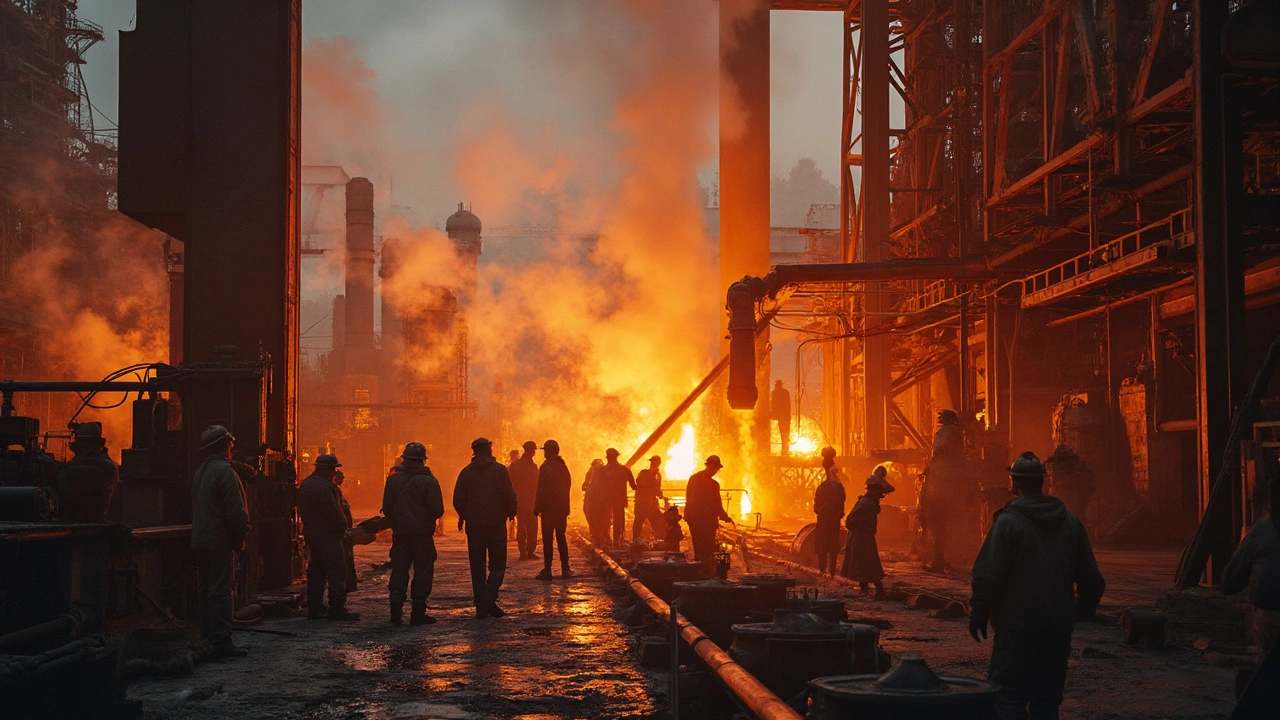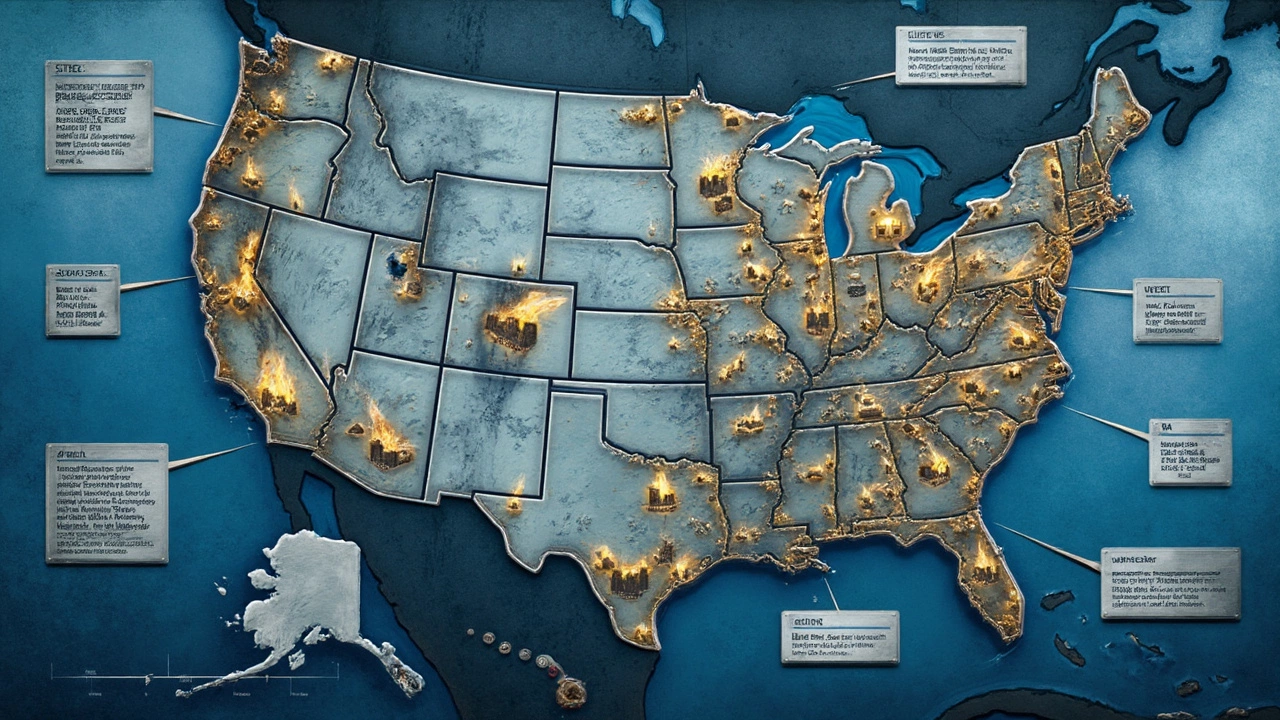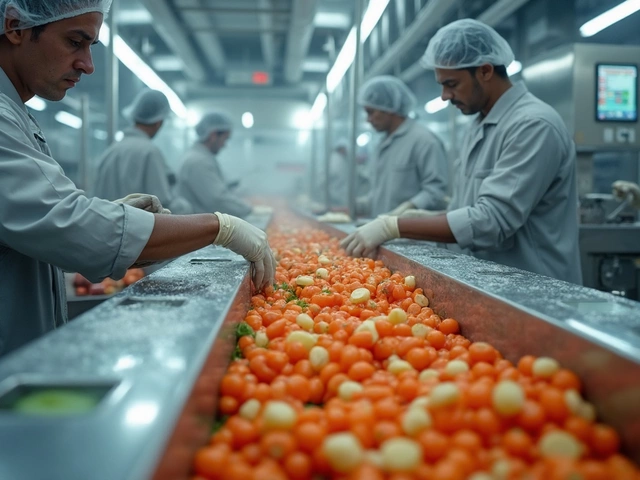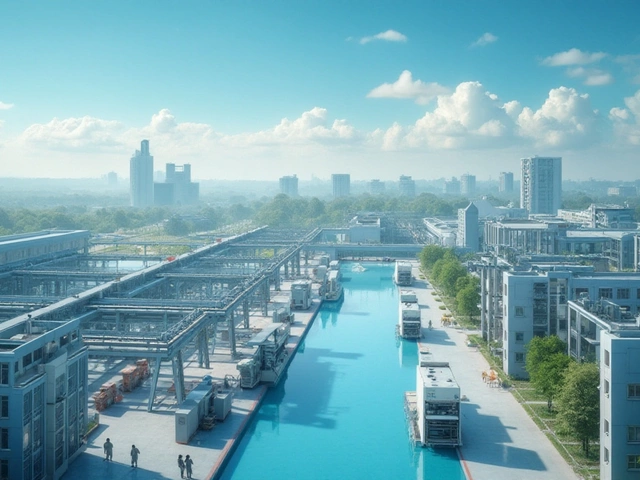Steel pretty much built America, but unless you work in the industry or live near a massive mill, chances are you don’t know exactly where those iconic U.S. Steel plants are hiding. People often picture smokestacks in Pittsburgh, but the story goes way bigger—and deeper—than just where the Steelers play. The reality is: U.S. Steel plants sprawl across the heartland, touch the Great Lakes, and even dip into the American South. They’re woven into the landscape, both geographically and culturally. Knowing their locations isn’t just about geography—these mills have shaped towns, driven economies, and pumped out the steel that makes up bridges, cars, rails, and even cans of food. Imagine crossing a city bridge and not realizing every inch of it traces back to molten steel poured in a giant plant miles away. That’s the kind of story these places hold—one that sprawls way beyond a dot on a map.
Steelmaking Strongholds: Where U.S. Steel Calls Home
Let’s get right to it—the main U.S. Steel plants dominate a stretch from the Midwest through the Northeast, but there’s more action than you’d expect. Everyone thinks Pittsburgh is the epicenter, and it’s true, the city is basically synonymous with steel. U.S. Steel’s corporate headquarters still sits in Pittsburgh, and the history there is thick—the rivers used to shimmer with coal dust, and the city lights glowed from blast furnaces. While Pittsburgh proper no longer hosts major hot metal operations, the burbs, especially around Mon Valley, still buzz with activity. The Edgar Thomson Plant in Braddock, for example, is the oldest steel mill in regular operation in America. This place has been melting iron since 1875—long enough to survive the Great Depression, two World Wars, and more than one steel bust. But people forget about the scale: the Mon Valley Works actually includes several sites—Edgar Thomson, Irvin Plant in West Mifflin, and the Clairton Plant, which is the largest coke manufacturing facility in the U.S. Coke, if you didn’t know, is a crucial ingredient in turning iron ore into real, tough steel.
Move west a bit, and you’ll hit Gary, Indiana. The Gary Works isn’t just big; it’s enormous. We’re talking over seven miles of plant running along the southern shore of Lake Michigan. This single plant can churn out more than 7 million tons of steel a year at its prime—enough to build every car in Detroit for years on end. Its scale makes Gary a legend among steel enthusiasts and a lifeblood for the local economy. It’s the city’s backbone: generations of families have punched their cards at Gary Works. U.S. Steel picked this location for easy shipping—lake freighters can bring in raw ore and carry out finished slabs right from the plant’s doorstep. Folks sometimes forget that location isn’t just about the ground underneath but the waterways that feed the demand.
Heading south, you find a newer chapter in the U.S. Steel story: Big River Steel in Osceola, Arkansas. This is the jewel when it comes to modern, green(er) steelmaking. Acquired by U.S. Steel in 2020, it’s a bet on the future. The South brings easy access to river ports and customers, cheap power, and steady labor. But the highlight is the electric arc furnace tech used here, which relies on recycled scrap steel and electricity instead of raw iron ore and coal. The Arkansas plant is cleaner, faster, and flexible—perfect for today’s specialty steels and those “greener” labels many industries demand.
You’ll also spot U.S. Steel operations scattered in places like Fairfield, Alabama. The Fairfield Works, once world-famous for its seamless pipe output, still spins off tubular products today. Tubing supports the energy industry, from gas pipelines to drilling rigs. You might not see powerhouse blast furnaces anymore, but finishing mills, coil lines, and processing charts keep the plant running, adapting to shifts in American energy and domestic manufacturing needs.
People usually miss the invisible thread connecting these sites—raw materials, products, and people zip between them by rail, barge, and truck. Steel may be solid, but its network is anything but static.
Mapping American Steel: The Role of Regional Advantages
Steel plants don’t pop up just anywhere. There’s a reason you’ll find most U.S. Steel plants near water—be it the Great Lakes, major rivers, or coastal ports. It’s no accident that Gary and Mon Valley are near rivers and lakes. Shipping iron ore used to mean 1,000-foot-long bulk carriers cruising from Minnesota’s Iron Range to the blast furnaces. Water access slashes costs, and believe it or not, a few cents saved per ton can mean millions over years. Even today, you’ll see mammoth ore boats making their slow crawl into Gary or Cleveland. These regions were also loaded with coal—another must-have—making it possible to set up an entire supply chain with everything within a day’s train ride.
Then there’s proximity to demand. Chicago, Detroit, and the Midwest are ground zero for car manufacturing—even as plants close or move, they gobble up tons of steel every week. Having those mills nearby isn’t just tradition, it’s practical. Same story for Pittsburgh—its rivers once carried goods up and down the Ohio and Mississippi, spinning out steel for rails, bridges, and factories. Today, being close to a customer still matters: construction firms want beams delivered fast, and carmakers tweak orders on the fly.
In the South, U.S. Steel’s Osceola operation serves a rising base of car plants and consumers. The South draws in steelmakers because of cheap electricity, lower labor costs, and friendlier weather—fewer blizzards to freeze a rail yard. Modern electric arc furnaces love regions where the grid is robust. Osceola’s location near the Mississippi River also puts it smack in the middle of a transport crossroads—barge, rail, and highway all converge, speeding shipments anywhere from Texas to Tennessee to the Gulf Coast. That means less inventory sitting on-site, less risk, and less waste.
It’s not just about moving stuff, though. Each plant shapes its town. Gary’s jobs paid mortgages, sent kids to college, and funded high school football fields. In Braddock by the Mon Valley Works, the mill is practically part of the town’s DNA—the hum of the plant is the lullaby at night. In Arkansas, Big River Steel has helped spark a manufacturing revival, drawing high-tech jobs and suppliers to a small corner of the Mississippi Delta.
All these locations do one more thing: they set the tone for how U.S. Steel competes. Midwest works focus on mass output and keeping up with auto demands. Mon Valley specializes in cleaner, higher-strength steels for modern construction. Osceola aims for everything from custom sheet to eco-friendly alloys. Each plays a part in the puzzle—and that’s what makes the U.S. Steel landscape so fascinating.

Inside the Steel Mills: What Goes On Behind the Fences
So, what’s it like inside one of these plants? You’re looking at acres of massive buildings, railroad tracks crisscrossing everywhere, and cranes swinging molten metal or coils of finished steel the size of a small car. At the giant Gary Works, blast furnaces run hot enough to melt rocks, pouring liquid iron at over 2,600 degrees Fahrenheit. Trains haul in iron ore, limestone, and coal and spit out slabs primed for rolling, coating, and shipping. The process looks brutal but is finely orchestrated—timing matters. If a furnace shuts down, production life stops, and hundreds might sit idle. That scale is mind-bending: you could walk for miles and still be inside plant boundaries.
The Mon Valley Works still echoes the early 1900s, but with modern tech keeping things efficient. Edgar Thomson, for example, is all about steel slabs hot off the line, shipped fast to the Irvin Works a few miles away to transform into coils ready to become cars, appliances, or beams. The Clairton Plant, vital for coke production, processes coal into a high-carbon fuel vital for steelmaking. Safety used to be an afterthought—accidents were common. Today, hundreds of cameras, sensors, and safeties mesh with old-school experience. Veteran steelworkers teach rookies the ropes, but computers track temperatures and chemistry, alerting teams if a batch drifts off specs.
At the Big River Steel mill in Osceola, the vibe shifts. Picture a high-tech factory floor, more modern than grungy—think gleaming white control rooms, robots stacking steel, and sensors charting every stage of the process. Electric arc furnaces melt scrap instead of raw ore—better for the planet and flexible enough to make a wide range of steel grades. Osceola might look nothing like Pittsburgh’s gritty mills of the past, but it’s still all about output, precision, and speed. The Arkansas crew brags about how fast they can switch product lines, or how they use less energy for every ton shipped out the door.
Fairfield, out in Alabama, is all about tubular goods now. Piping for oil, gas, and water—all depend on big, seamless tubes. The plant uses specialized equipment—piercing mills that turn steel billets into pipes by forcing hot metal around a spinning cone. That work’s high-stakes—nothing can go wrong with a pipe that’ll run miles beneath ocean floors. A missed defect could mean disaster months or years later. Quality control here is next-level: ultrasonic testing, X-rays, and dozens of checks before anything leaves the site.
Anyone who has ever worked at any U.S. Steel plant knows that daily life is shaped by shift whistles, steel-toed boots, and the tension between production goals and personal safety. Mill jobs are some of the best-paying blue-collar gigs in the country, but they demand respect—one slip, and you’re in the emergency room. At the same time, unions and management wrestle to balance profits with keeping those jobs local. It’s not always easy or pretty, but it’s as real as it gets.
The Future of U.S. Steel Plants: Trends and What to Watch For
Here’s where things get interesting. U.S. Steel once mapped its empire by rivers and rail, but now the biggest shifts come from technology and environmental rules. The push for greener steel is real. Nobody wants coal smoke downtown anymore, and investors want to see companies using less energy and producing less waste. That’s why Big River Steel in Arkansas signals a turning point: instead of coal-fired blast furnaces, electric arc furnaces chew up scrap metal—old cars, appliances, demolished buildings—and spit out clean new steel. U.S. Steel poured billions into expanding this plant, betting the house that more customers will care about carbon footprints and less about whether steel was made by pouring iron ore or today’s scrap pile.
In the Midwest, classic mills like Gary Works are working overtime to stay relevant. They’ve invested in cleaner technologies and scrubbers to meet tight air pollution limits. But the big question: how much longer will older blast furnaces run? The auto industry wants lighter, high-strength steel for electric cars, and construction needs more custom blends. Can classic mills shift quickly enough to survive? If you follow steel news, you’ll know Gary and Mon Valley are on the “must modernize” list. Fresh capital means better jobs and production, but layoffs loom if upgrades come too late.
Not every region is primed for growth. Areas with higher electricity prices or fewer young workers face extra challenges. Automation and AI are creeping in—check out Osceola’s plant, where sensors predict when a machine needs fixing so repairs happen before things blow up. That means fewer breakdowns and less wasted steel, but it also means jobs shift from brute muscle to skilled troubleshooting. Expect more training, more tech skills, and probably new kinds of jobs no one was teaching ten years ago.
Steel’s ties to American life stay strong, but there are global winds blowing, too. Cheap steel from overseas has hammered some U.S. mills, leaving places like Lorain, Ohio, or other small towns quiet, with empty rails and boarded-up storefronts. Trade policies, import tariffs, and the fate of domestic auto plants—the whole chess match means the map of U.S. Steel plant locations could look different in a decade.
If you’re tracking where American steel’s future lies, keep an eye on places like Osceola—or on old standbys like Gary if they manage a high-tech turnaround. U.S. Steel plants aren’t just about making beams and coils; they’re markers of where American industry stands and where it’s heading.






